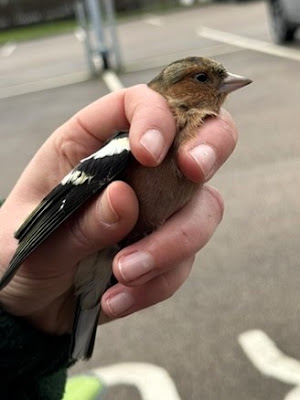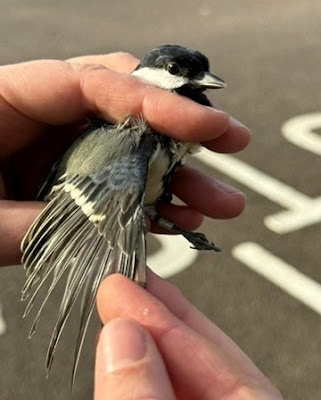This year, we wanted to get to the bottom of whether juvenile Goldfinches were undergoing an eccentric or descendent primary moult. Eccentric moult is when only a few central primaries are replaced, compared to descendent which follows the usual moult pattern by starting at the inner primaries and working outwards.
Svensson 5th edition says that “A few British juveniles and a higher proportion from more southerly populations moult tertials, tail feathers, and one or several central primaries in Autumn.” It also gives the juvenile moult strategy as “Young: sp; (SC-)”, with the hyphen after SC indicating that any complete moult is typically arrested. If some birds may be starting a complete moult, while others replace only a few central primaries, we could be looking for birds with either an eccentric or descendent moult pattern.
There are a number of features that we can look for:
- vibrancy and shape of the yellow outer web
- brightness and shape of the white terminal dot
- black glossiness
- wear on the tips
Let's look at some of these variations in detail -

Above: Age 3, Moult P.
This is a typical juvenile wing showing no primary moult. You can clearly see that the yellow webs are dull, all the tips are buff, and the white dot is concave in shape. However, there is a lot of variation so it’s worth comparing this with one that is a bit more tricky.

Above: Age 3, Moult P.
This is also a juvenile wing showing no moult. But you can see that the yellow is much brighter, the black background is glossier, and the white dots have less buff. However, these features are consistent across the whole wing - there’s no difference in yellow between one feather and the next, the angle of the yellow tip even, wear on the tips is even, the white dots are all concave, and the black gradually fades to brown on the outer feathers as we would expect.

Above: Age 3, Moult F, Moult score 0000550000.
This is my most obvious example of a juvenile showing eccentric moult. The difference in the brightness of the yellow is clear to see on P5 and P6. There’s a big difference in wear on the tips with P4 being frayed and P5 being completely fresh. Between P6 and P7, you can see a step change in the black background as P6 is glossy and P7 is faded. However, again, not all are this easy so let’s compare…

Above: Age 3, Moult F, Moult score 0000550000.
This is my most subtle example. With no active moult, and no difference in colour across the wing, you can see how this would be easy to miss. But anyone looking out for eccentric moult will notice the difference in wear on the tips of P4 and P5. If you look even closer, the new P5 and P6 have a less acute angle on the yellow tip, giving them a slightly blunt ended appearance in comparison to the others. Arguably, the yellow web on P5 and P6 is also longer.

Above: Age 3, Moult F, Moult score 0000550000.
Beware the black background! This is another subtle example, and a warning against using the black background as a key feature. If you recall the first two photos of birds that weren’t showing any primary moult, the black background gradually and naturally fades from dark and glossy on the inner primaries to faded brown on the outer primaries. This bird has replaced P5 and P6, but there is no difference in black glossiness between the old P4 and the P5, which may lead the uninitiated to miss this moult entirely, or to assume it was descendent. The change in black from P6 and P7 is visible, as we would expect. However, if you look at the wear you can clearly see a difference in age between P4 and P5, and now that you know what to look for, you can see that the yellow web is more rounded on P5 and P6 too.
I advocate using all the features to reach a conclusion. Wear on the tip is the most reliable as it doesn’t vary between birds, unlike shape, vibrancy and glossiness.
Out of 268 Goldfinches I’ve caught in the garden this year, 15 have completed an eccentric moult, which is 5%. Jenni and Winkler say in ‘Moult and Ageing of European Passerines’ that 3-4% of British Goldfinches undergo a complete moult, but I am yet to be lucky enough to find evidence of that!
Why this is important
You may be wondering why any of this matters. It is, after all, only a couple of replaced feathers. But it is important to record eccentric moult accurately because:
- At worst, some ringers may misidentify active primary moult as the main moult completed by adults. This means that they would incorrectly age juveniles as adults which affects national data.
- Other ringers may assume the primary moult is descendant rather than eccentric, and they record inaccurate moult scores. This gives a false indication of the extent of post-juvenile moult. As everyone keeps talking about how birds these days are moulting more because of climate change, it’s more important than ever that we collect accurate data to evidence any change.
- For juveniles that have completed an eccentric moult, it is very easy to miss the newly replaced feathers from Autumn onwards. This means that the number of birds that undergo an eccentric moult is not accurately recorded.
- The scientific journals on eccentric moult are out of date. British studies were last conducted in the 1980s, and more recent studies were undertaken on a different subspecies of Goldfinch on the Balearic Islands. If birds have changed in the 40 years since these papers were published, it means that the field guides are out of date and we need to be looking more closely at birds when they are in the hand.
If nothing else, I hope this analysis helps you to appreciate the variety that can be found in a very common garden bird if you look hard enough.
Holly















